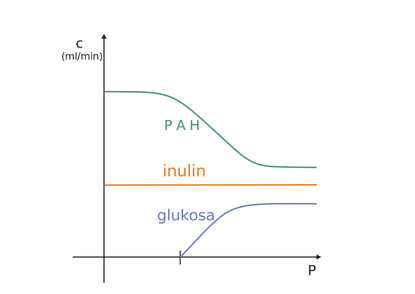Ways of excretion
Ways of elimination[edit | edit source]
The glomerular filtrate flows out of the glomerulus and becomes a tubular fluid, where secretion or reabsorption of substances contained in it can occur. These mechanisms can be combined in different ways, so there are 4 ways of excretion:
- net glomerular filtration,
- glomerular filtration and secretion,
- glomerular filtration with reverse reabsorption,
- excretion only by tubular secretion.
Net glomerular filtration[edit | edit source]
Inulin (a polymer of fructose found in the ornamental dahlia plant) is best used to measure glomerular filtration in humans. You need a substance that is purely filtered, not secreted or reabsorbed back in the tubules, so there is the same amount in GF as in plasma. In addition, it must not be metabolized and, of course, must not be toxic. Then the GF is calculated as the concentration of the given substance in the urine (UX) times the amount of urine (V) divided by the arterial plasma concentration of the given substance (PX), i.e. UXV/PX . This value is called the Clearance of the given substance (CX). Some radioisotopes can also be used . Creatinine is also commonly used, especially in animalsdue to easy availability. Unfortunately, it is not the most suitable for humans, as creatinine is secreted and reabsorbed in the tubules to a small extent. In addition, it is imprecise when determining the plasma concentration of creatinine, because the method also determines substances other than creatinine, especially at low plasma concentrations.
Glomerular filtration and secretion[edit | edit source]
With the help of such substances, the rate of flow through the kidneys is measured. A substance is needed to measure the RPF (renal plasma flow) rate through the kidneys , it is completely excreted into the urine, which is not only filtered into the GF, but also subsequently secreted by the tubules. This substance must pass through the glomerular and peritubular channels. It cannot be metabolized or reabsorbed back. Thus, the clearance of such a substance with 100% extraction is a method of measuring RPF (renal plasma flow - measure of blood flow through the kidneys). A substance that meets these requirements and is also commonly used is para-aminohippuronic acid PAH. So PAH Clearance is RPF. This acid is partially filtered, which is a linear function, and for the most part then secreted from the efferent arteriole into the lumen of the tubules. The secretion rises only to a certain extent, until the maximum secretion value (TmPAH) is reached . When the plasma PAH concentration is low, the ClearancePAH is high, but when the plasma PAH concentration rises above the TmPAH, the ClearancePAH decreases until it almost approaches the clearance of inulin. Because the amount of secreted PAH is an ever smaller fraction of the total amount excreted. In addition to PAHs, other hippuronic acid derivatives, phenol red, penicillin and a whole range of iodinated dyes (e.g. Diodrast) are actively secreted .
Inulin is only filtered, it is neither secreted, absorbed nor metabolized, therefore there is the same amount in the glomerular filtrate as in the blood plasma – a linear function. Para-aminohippuronic acid is partially filtered, which is a linear function, and for the most part then secreted from the efferent arteriole into the tubule lumen. The secretion rises only to a certain extent, until the maximum secretion value is reached. If there is more of it, the graph becomes linear, as the rate of filtration and secretion remains the same, regardless of the amount of PAH in the blood plasma . Glucoseis filtered out but absorbed back into the blood. The kidneys can reabsorb filtered glucose if it does not exceed a critical value, the so-called tubular transport maximum. The above-threshold value of glucose is thus eliminated in the urine.
Glomerular filtration with reverse reabsorption[edit | edit source]
In another method of excretion, glomerular filtration is combined with retrograde reabsorption . Part of this substance is returned to the peritubular bed by means of transport mechanisms. The excluded amount of such a substance is always lower than the amount that was filtered (e.g. urea ). Threshold substances are a special type , which are completely reabsorbed in the tubules if they do not exceed the transport maximum (Tm) . A typical example is glucose. The renal threshold for glucose is plasma, at which it first appears in the urine in greater than minimal normal amounts. Numerically, it is approximately 300 mg/100 ml (16.65 mmol/l).
Excretion by tubular secretion only[edit | edit source]
In the latter case, the substance is eliminated only by tubular secretion . It was not contained in the blood, therefore it was not filtered and must be formed in the renal parenchyma in the tubular cells. A typical example is ammonia .
Links[edit | edit source]
References[edit | edit source]
- http://web.natur.cuni.cz/fyziol/odd_neuro/6b_07.pdf
- TROJAN, Stanislav, et al. Medical physiology. 4., reworked and edited edition. Prague : Grada Publishing, a.s, 2003. 772 pp. ISBN 80-247-0512-5.

